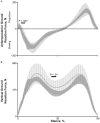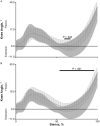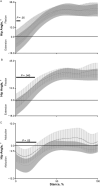Preoperative and Postoperative Walking Gait in Women With Acetabular Labral Tears and Femoroacetabular Impingement Syndrome
- PMID: 36356614
- PMCID: PMC9661926
- DOI: 10.4085/1062-6050-0026.21
Preoperative and Postoperative Walking Gait in Women With Acetabular Labral Tears and Femoroacetabular Impingement Syndrome
Abstract
Context: Symptomatic femoroacetabular impingement syndrome (FAIS) is a painful condition that leads to decreased function. How walking gait changes over time within the first year after surgery for FAIS and how these changes present in women are currently unknown.
Objective: To determine biomechanical gait differences between women with FAIS or labral tears and control individuals preoperatively and at 3 and 6 months postoperatively.
Design: Case-control study.
Setting: Laboratory.
Patients or other participants: A total of 18 female participants comprising 9 women in the FAIS group (age = 31.44 ± 7.47 years, height = 1.73 ± 0.08 m, mass = 73.61 ± 14.44 kg) and 9 women in the control group (age = 31.44 ± 6.65 years, height = 1.69 ± 0.06 m, mass = 60.93 ± 5.58 kg).
Main outcome measure(s): Between-groups comparisons of the Hip Outcome Score Activities of Daily Living subscale (HOSADL) and gait biomechanics were conducted preoperatively and at the 3- and 6-month postoperative sessions. Statistical parametric mapping was performed on normalized time-series data.
Results: Preoperatively, the FAIS group had poor HOSADL scores (FAIS group = 64.1 ± 15.4 versus control group = 100.0 ± 0, P < .001), walked 15% slower, and exhibited several gait differences compared with the control group. Three months postoperatively, the FAIS group displayed greater vertical ground reaction force (P = .01), ankle-dorsiflexion angle (P = .02), and external dorsiflexion moment (P = .01) in midstance, as well as a greater knee-flexion angle through the second half of stance (P < .001). The FAIS group also demonstrated less hip-extension angle (P = .02) and hip-abduction angle (P = .01) through the second half of stance, which transitioned into less hip extension (P = .040) and hip abduction (P = .03) during the subsequent swing phase. The FAIS group improved their HOSADL to 87.6 ± 7.6 by 6 months postoperatively and had a greater dorsiflexion moment (P = .003) and ankle external rotation during stance (P = .03). In addition, the FAIS group showed a greater external hip external-rotation moment in late stance (P < .001).
Conclusions: The biomechanical differences between groups were most evident at 3 months postoperatively, suggesting that women with FAIS had more postoperative gait compensations in the short term after surgery. By 6 months postoperatively, patient-reported outcomes had markedly improved, and the FAIS group displayed few gait differences compared with the control group.
Keywords: females; hip arthroscopy.
© by the National Athletic Trainers' Association, Inc.
Figures





References
MeSH terms
LinkOut - more resources
Full Text Sources

